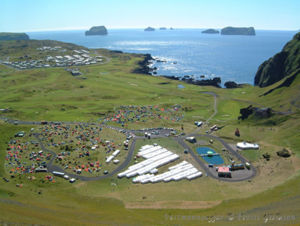Culture and Art

The cultural life in Vestmannaeyjar still reflects to a considerable extent their past geographical isolation, the need for self-sufficiency in most things through the centuries. There simply was no place else to go for most things, including social life and enjoyment, culture and art. This is probably best exemplified by Vestmannaeyjar “national” festival. In the year 1874 when Icelanders thronged to Þingvellir to celebrate the country´s constitution, bad weather forced the islanders to stay home. As ever unwilling to miss a good party, they simply held their own “national” festival in Herjólfsdalur. This was such a resounding success that it is still being held every year; now turning things around and attracting thousands of mainland visitors, having become the most popular outdoor festival in the country.
Music is very much a part of the islands´ cultural inheritance, the ”island songs” being an inseperable part of every inhabitant´s upbringing. In preschool, if not before, children learn songs and lyrics connected to the islands, both old folksongs and songs by local musicians :Oddgeir Kristjánsson, Ási í Bæ and Árni úr Eyjum, to name but three. They are frequently sung on all sorts of social occasions, the famous hillside singalong, anindispensable part of the national festival, being a good example. On this as on other occasions, the locals do not need printed hand-outs, they know both songs and lyrics by heart. A music school thrives in the islands, a venerable, but still young brass band, choirs, diverse singing groups, and bands of all descriptions, mostly manned by the younger generation. Not many small Icelandic communities can boast of a richer musical heritage than Vestmannaeyjar.
The need for self sufficiency also made its mark on the dramatic arts. An ambitious local amateur theatre company stages 2-3 plays a year, besides other events. During the summer a street theatre enlivens the town. This group is operated by the theatre company in collaboration with the town´s “Vinnuskóli” (employing teenagers during the summer holiday).
There are two primary schools in the islands, three preschools, an art school, and a comprehensive school that also offers industrial/vocational education. On Heimaey the University of Iceland operates a research centre and the Marine Research Institute a branch laboratory.
A visitor once remarked that by bringing about the magnificent landscape, the Creator had made human art forms superfluous. Nevertheless, island people have not let that hinder them in placing works of art around and outside town, works by well-known Icelandic sculptors like Ásmundur Sveinsson and Einar Jónsson, as well as artists less well known.
In 1999 the project “Lava and man” was set afoot, a collaboration of 23 Nordic artists creating artworks from lava and island rocks. The island population has considerable interest in the fine arts and a number of exhibitions are held every year by locals and visitors from the mainland alike. The Natural History Museum is the best known of the island museums, the best of its kind in the country with a fine collection of live fish and other sea creatures of the sea as well as stuffed birds and a unique collection of Icelandic minerals.
Safnahúsið (the House of Collections) contains a large and well-stocked library, the municipal archives, a photographic musem, an art museum, a large collection of the works of the painter Jóhannes Kjarval, and the Folk Museum that has by now become especially “user friendly” and interesting. Close by is Landlyst, the second oldest building in the islands, now rebuilt, housing a medical museum.